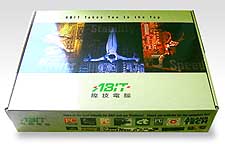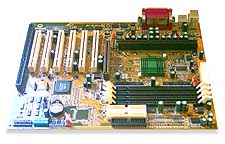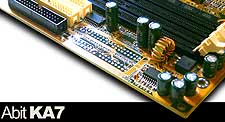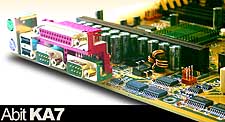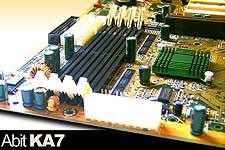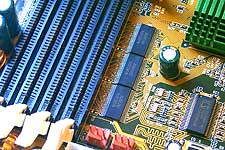Ik heb ff een paar foto's geschoten van de KA7 die ik hier dankzij CompTechWorld heb liggen:
Reacties (33)
altavista babelfish translator:
Mother board > Abit KA7 > Introduction and presentation (1/4)
Well-known Abit for its famous and very good mother boards for processors INTEL (randomly let us quote the BH6, the BE6 2.0...), lance today and for the first time of its history a mother board for Athlon, the KA7.
Considering the stability and the possibilities of overclocking which have the other mother boards Abit, the KA7, was awaited impatiently by the owners of Athlon.
Thus let us see if Abit always made honor with its image in the field of processors AMD.
Presentation:
The KA7 differs from the old mother boards Athlon on several points.
First of all it is based on new the chipset Athlon from Via, the KX133. This last offers many evolutions compared to " old " the chipset AMD 750 which equips the majority with the mother boards current Athlon since the chipset Via KX133 supports as its name indicates it against a frequency of bus report of 133 MHz (independent of the frequency of the bus) 100 MHz for the AMD 750. In addition the KX133, just like the i820 of INTEL for the mother boards Pentium III, make it possible to exploit the AGP in 4x mode and the UDMA 66. It is thus logical to find on the KA7 a port AGP 4x and two ports IDE compatible UDMA66, for the remainder it is a little more traditional but it is always turned towards the evolutionary one since 6 ports NCV are found, a port ISA and 4 sites report SDRAM (on this subject know that Abit KA7 is equipped with 6 judicious chips Data Buffer to stabilize the system when the four sites reports are used).
Dimensioned interfacing nothing extraordinary: two ports USB, two ports COM, a port LPT and two ports PS/2 equip Abit KA7. Cependant one will notice the presence of four Fan connectors (for ventilators) which are just like the connector of the feeding laid out very well. Lastly, to finish with the presentation of the card to be strictly accurate, let us specify that like all the new mother boards Abit, the KA7, is equipped with " Dip Switch " which makes it possible to regulate the frequency of the processor using small switch without passing by Bios .
Separately the mother board KA7, one finds in limps of this one: a handbook use " Switch Software " (unfortunately entirely in English), a tablecloth UDMA66, a Floppy-Disk tablecloth, CD of installation with the drivers for Chipset Via, and, small innovation, like us had announced it to you in our news, CD on which is the special version Abit de Linux baptized " Gentus Linux ". Also let us note the usual presence of a thermal probe.
To finish know that the installation was done without problems and apparently Abit KA7 does not seem to be particularly demanding as for the quality of the feeding of the central processing unit contrary to a certain K7M.
The presentations being made, lean we a little more on this new chipset which is it Via KX133.
=]
Mother board > Abit KA7 > Introduction and presentation (1/4)
Well-known Abit for its famous and very good mother boards for processors INTEL (randomly let us quote the BH6, the BE6 2.0...), lance today and for the first time of its history a mother board for Athlon, the KA7.
Considering the stability and the possibilities of overclocking which have the other mother boards Abit, the KA7, was awaited impatiently by the owners of Athlon.
Thus let us see if Abit always made honor with its image in the field of processors AMD.
Presentation:
The KA7 differs from the old mother boards Athlon on several points.
First of all it is based on new the chipset Athlon from Via, the KX133. This last offers many evolutions compared to " old " the chipset AMD 750 which equips the majority with the mother boards current Athlon since the chipset Via KX133 supports as its name indicates it against a frequency of bus report of 133 MHz (independent of the frequency of the bus) 100 MHz for the AMD 750. In addition the KX133, just like the i820 of INTEL for the mother boards Pentium III, make it possible to exploit the AGP in 4x mode and the UDMA 66. It is thus logical to find on the KA7 a port AGP 4x and two ports IDE compatible UDMA66, for the remainder it is a little more traditional but it is always turned towards the evolutionary one since 6 ports NCV are found, a port ISA and 4 sites report SDRAM (on this subject know that Abit KA7 is equipped with 6 judicious chips Data Buffer to stabilize the system when the four sites reports are used).
Dimensioned interfacing nothing extraordinary: two ports USB, two ports COM, a port LPT and two ports PS/2 equip Abit KA7. Cependant one will notice the presence of four Fan connectors (for ventilators) which are just like the connector of the feeding laid out very well. Lastly, to finish with the presentation of the card to be strictly accurate, let us specify that like all the new mother boards Abit, the KA7, is equipped with " Dip Switch " which makes it possible to regulate the frequency of the processor using small switch without passing by Bios .
Separately the mother board KA7, one finds in limps of this one: a handbook use " Switch Software " (unfortunately entirely in English), a tablecloth UDMA66, a Floppy-Disk tablecloth, CD of installation with the drivers for Chipset Via, and, small innovation, like us had announced it to you in our news, CD on which is the special version Abit de Linux baptized " Gentus Linux ". Also let us note the usual presence of a thermal probe.
To finish know that the installation was done without problems and apparently Abit KA7 does not seem to be particularly demanding as for the quality of the feeding of the central processing unit contrary to a certain K7M.
The presentations being made, lean we a little more on this new chipset which is it Via KX133.
=]
Femme: hoe maak je die foto's? Een tijdje terug wilde ik ook foto's maken van een stukkie hardware, maar dat is hopeloos mislukt (niet verbazend, aangezien ik een kleinbeeld camera en een bureau-lamp als belichting gebruikte  ). Heb jij duur spul of ben je gewoon heel handig?
). Heb jij duur spul of ben je gewoon heel handig?
Volgens mij issie gewoon handig 
Ik heb een Kodak DC265. Omdat ik de flits niet wil gebruiken (dan ik om de 10 minuten batterijen gaan swappen) zet ik dat ding op een statief en gebruik ik te timer om foto's te maken (uit de losse hand krijg je ze niet scherp). Vervolgens een beetje fotosoppen om gamma en kleuren goed te krijgen en om eventuele irritante achtergronden weg te halen.
Absoluut off topic en slecht voor mijn score:
Ik vind die doos wel mooi
/me TgF
Ik vind die doos wel mooi
/me TgF
Zie ik daar nu ontbrekende IDE-connectors ?
Hmmmz....
* GaMeOvEr GaMeOvEr
Hmmmz....
* GaMeOvEr GaMeOvEr
gameover, kun je niet kijken?
ik zie toch 4 dimm sloten..
ik zie toch 4 dimm sloten..
Doet nog eens tel....
erm het zijn er wel degelijk 4 hoor...  . We zullen het er maar op houden dat het bijna weekend is...
. We zullen het er maar op houden dat het bijna weekend is... 
Het systeem is als volgt:
we beginnen met 1, daarna volgt 2, op de voet gevolgd (maar niet ingehaald) 3 en als laatste in de rij van vier, volgt 4

Ik hoop hiermee e.e.a. opgehelderd te hebben
we beginnen met 1, daarna volgt 2, op de voet gevolgd (maar niet ingehaald) 3 en als laatste in de rij van vier, volgt 4
Ik hoop hiermee e.e.a. opgehelderd te hebben
Op dit item kan niet meer gereageerd worden.
